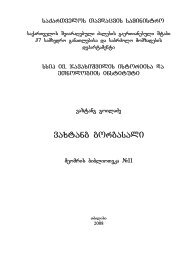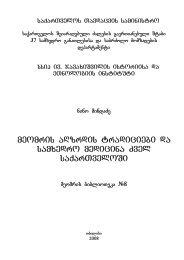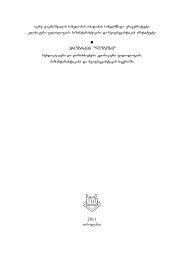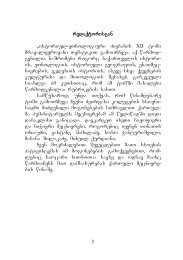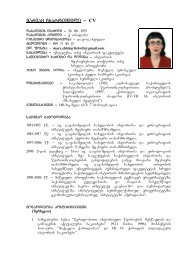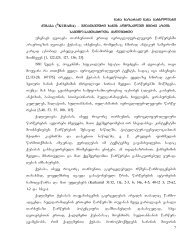programa "logosi"
programa "logosi"
programa "logosi"
Sie wollen auch ein ePaper? Erhöhen Sie die Reichweite Ihrer Titel.
YUMPU macht aus Druck-PDFs automatisch weboptimierte ePaper, die Google liebt.
150<br />
Manana Khidasheli<br />
DWELLINGS OF INNER KARTLI IN THE LATE BRONZE-<br />
EARLY IRON AGE<br />
In culturology the dwelling of ancient man is considered not only as the<br />
place of his habitation, but also as the significant cultural realia, artifact, a<br />
polysemantic symbol. The meaning of this symbol is disclosed most fully in<br />
the early farming cultures. The dwelling was simultaneously the place<br />
where man lived as well as the place of the performance of the cult. The<br />
dead were also buried here, under the floor. Rituals were performed at the<br />
hearth. The hearth had the female nature, the embodiment of the male power<br />
were stands of the hearth, which represented male idols. They fecundated<br />
the hearth and, as a result, life began anew. The symbol of the renewed<br />
world was the central pillar and the tree, fastened in the hearth stands.<br />
In the Late Bronze Age a new stage began in the development of the<br />
culture of Inner Kartli. The culture widespread here was homogeneous. At<br />
that period the territory was intensively settled. Khovlegora, Tskhinvali<br />
Natsargora, Qatnaliskhevi hill, Narekvavi hill, etc. are especially wellknown<br />
hill settlements of that period.<br />
One common regularity is observable in the development of hill settlements.<br />
Circa the 15 th -13 rd cc. BC the population settled at the summit of the<br />
hill, which was protected by special trenches. Gradually the population left<br />
the hill and moved to its foot.<br />
In the hill settlements of Inner Kartli dwellings of a single type occurred.<br />
This was a rectangular building. The flat roof was supported by wooden<br />
pillars. A low partition divided the house in two sections. The left part was<br />
the human dwelling, and the right one – the cattle stall. A door was made in<br />
front of the stove. The house had a corridor in front of it. Sometimes a small<br />
window was found on top of the stove.<br />
The dwelling provides interesting information concerning the everyday<br />
life culture of man of that period. A stove was placed in the left corner of<br />
the dwelling room. Often shelves were made next to the stove. Sometimes<br />
benches were also found at the back wall. On them were placed the lamps<br />
Lamps, whose fire was lit without putting out. There was an altar in each<br />
room.<br />
An extremely interesting "palace", belonging to the 6 th c. B.C. was discovered<br />
at the foot of Khovlegora. It was located inside the fortification<br />
wall. The area of the building was 147 sq.m. It consisted of four rooms. A<br />
47sq.m. room, leading to a round tower, is of interest. In the room there was<br />
a stove, a hearth, a long coach faced with stone slabs, a shelf along the wall,






